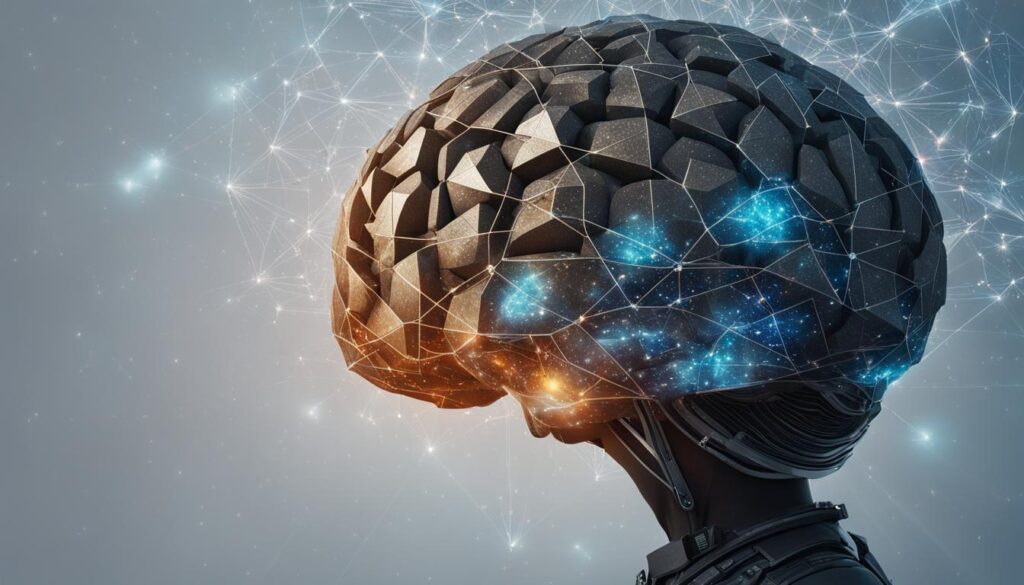OpenAI’s most recent advancement in AI research introduces the Q* model, which marks a major step forward in enhancing artificial data. By blending tree-of-thoughts reasoning with process reward models, this cutting-edge AI development is set to revolutionize multiple industries and set the stage for further progress in artificial intelligence.
By leveraging tree-of-thoughts reasoning, the Q* model enhances the AI’s ability to process complex information and make informed decisions. This approach allows the model to navigate through multiple steps and build a rich understanding of data, resulting in more accurate and valuable insights.
In addition, the integration of process reward models provides a powerful mechanism for the AI system to learn and optimize its performance over time. By rewarding successful outcomes and adjusting its strategies accordingly, the Q* model can continually improve and adapt to dynamic environments.
Key Takeaways:
- Tree-of-thoughts reasoning and process reward models are at the core of the Q* model’s capabilities.
- The Q* model enhances synthetic data by enabling deeper understanding and more accurate decision-making.
- By leveraging multiple steps and complex reasoning, the Q* model offers greater insights and valuable outputs.
- Process reward models enable the AI system to continuously learn, adapt, and optimize its performance.
- The Q* model has the potential to revolutionize various industries and advance the field of artificial intelligence.
Introduction to OpenAI’s Q* Model
OpenAI’s Q* model, pronounced Q star, has made waves in the AI community with its breakthrough capabilities in solving grade-school level math problems. Developed by researchers at OpenAI, this model represents a significant milestone in AI systems and has the potential to drive advancements in artificial general intelligence (AGI).
One of the key highlights of the Q* model is its ability to perform math tasks at a level comparable to grade-school students. This breakthrough opens up a wide range of applications and implications for fields such as education, research, engineering, and beyond.
By enabling AI systems to solve math problems, OpenAI’s Q* model can contribute to scientific research by aiding in complex calculations and analysis. It can also assist in engineering by offering optimization solutions and designing innovative systems. Additionally, the model can be leveraged in personalized tutoring to provide tailored guidance and support to learners.
Understanding the Significance of Math Capability in AI
Math capability in AI systems plays a crucial role in advancing artificial general intelligence (AGI) and pushing the boundaries of reasoning. While current language models can handle some math tasks, they are not proficient in solving math problems like humans. Math is considered a benchmark for reasoning, and a machine that excels at math has the potential to learn other complex tasks that build on existing mathematical knowledge.
However, solving math problems requires a deep understanding of concepts and the ability to plan and reason over multiple steps. Current AI models still struggle with these aspects, which hinders their ability to solve math problems reliably. The development of math-capable AI systems, like OpenAI’s Q*, represents an important step towards bridging this gap and enhancing the reasoning capabilities of AI.
By integrating math capability into AI systems, researchers aim to develop models that can not only solve math problems but also apply their reasoning abilities to various domains. This includes scientific research, engineering, personalized tutoring, and more. The potential applications are vast, and math-capable AI systems have the potential to revolutionize these fields by providing accurate and efficient solutions.
Despite the progress made, challenges remain in developing AI systems with robust math capability. Deep understanding of mathematical concepts, reasoning, planning, and abstract thinking are still areas where AI models struggle. Further research and innovation are needed to overcome these challenges and develop math-capable AI systems that can reliably solve a wide range of math problems.
Importance of Math Capability in AI Systems
“Math capability is a crucial component in advancing AI systems towards artificial general intelligence. By developing math-capable AI models, we can enhance their reasoning abilities, allowing them to solve complex problems and make informed decisions.”
| Benefits of Math Capability in AI | Challenges in Developing Math-Capable AI Systems |
|---|---|
|
|
Math capability in AI systems has the potential to drive innovation and transformation across various fields. However, addressing the challenges and limitations is crucial to ensure the responsible and beneficial use of math-capable AI systems.
Evaluating the Potential of Q* in AI Development
While the Q* model has generated excitement in the AI community, it is important to understand the limitations and implications of its math capability. Solving elementary-school math problems is different from pushing the boundaries of mathematics at the level of top mathematicians. The Q* model’s ability to perform grade-school level math does not necessarily imply progress towards achieving Artificial General Intelligence (AGI) or superintelligence. It is essential to approach the Q* model’s capabilities with caution and a realistic understanding of its limitations.
AI development requires more than just math-solving abilities. Building AGI systems that can reason, plan, and understand complex concepts is a challenging task that goes beyond solving math problems. While the Q* model showcases advancements in math reasoning, it is still far from achieving a comprehensive understanding of mathematics at a higher level. AI researchers need to address the limitations of the Q* model and continue developing AI systems that can excel in various areas beyond mathematics.
Moreover, there are safety and ethical considerations associated with allowing AI systems to set their own goals based solely on their math capabilities. The potential risks and unintended consequences of AI systems autonomously determining goals need to be carefully examined and regulated. Ethical guidelines and regulations should be established to ensure the responsible and beneficial use of math-capable AI systems.
| Limitations of the Q* Model in AI Development | Implications |
|---|---|
| The Q* model’s math-solving capabilities are limited to grade-school level problems. | This restricts its applicability in complex mathematical domains. |
| AI development requires a broader range of capabilities beyond math-solving. | AI systems need to excel in reasoning, planning, and understanding complex concepts. |
| Safety and ethical concerns arise from allowing AI systems to set goals based solely on math capabilities. | Regulations and guidelines must be established to ensure responsible use. |
“While the Q* model showcases the ability to solve grade-school level math problems, it is crucial to recognize the distinction between math-solving and advancing the boundaries of mathematics. We must approach the Q* model’s capabilities with realistic expectations and consider the larger challenges that AI development entails.” – AI Researcher
Applications of Math Capability in AI
AI systems with math capability have a wide range of applications across various fields, including scientific research, engineering, and personalized tutoring. The ability to solve math problems enhances the capabilities of these systems and enables them to contribute to complex tasks and decision-making processes.
In scientific research, AI models with math capability can assist in complex calculations and data analysis. They can process large amounts of data and generate insights that aid researchers in their investigations. The mathematical reasoning capabilities of these models allow for precise and accurate analysis, contributing to advancements in scientific knowledge.
In the field of engineering, AI systems with math capability can be employed in design optimization and system analysis. These models can assist engineers in finding the most efficient solutions and predicting the performance of different designs. By leveraging math capabilities, AI can enhance engineering processes and facilitate the development of innovative solutions.
AI models with math capability can provide personalized tutoring in math subjects. They can generate math responses and offer tailored guidance to learners, adapting to their individual needs and learning styles. This personalized approach improves the effectiveness of math education and helps students develop stronger skills and understanding in the subject.
The Potential of AI in Personalized Tutoring
Personalized tutoring is a key area where math-capable AI systems can make a significant impact. These systems can analyze students’ strengths and weaknesses in math and provide targeted exercises and explanations to address their specific needs. By offering personalized feedback and support, AI tutoring systems can enhance learning outcomes and create a more engaging and effective learning experience.
| Field | Applications |
|---|---|
| Scientific Research | Complex calculations Data analysis Insights generation |
| Engineering | Design optimization System analysis Innovative solutions |
| Personalized Tutoring | Tailored guidance Adaptive learning Improved math education |
Overall, the integration of math capability in AI systems opens up new possibilities and applications in scientific research, engineering, and education. These systems have the potential to enhance problem-solving, decision-making, and learning processes, fostering innovation and improving outcomes in various domains.
The Role of Q* in AI Progression
The development of the Q* model represents a significant step forward in the progression of AI research and technology. While it may not immediately lead to the creation of artificial general intelligence (AGI) or superintelligence, it contributes to the ongoing advancements in AI innovation. The insights gained from building models like Q* can inform future developments and help researchers navigate the challenges and possibilities of creating more powerful and capable AI systems.
By pushing the boundaries of current AI capabilities, the Q* model showcases the potential for further advancements in the field. It serves as a building block for future breakthroughs and innovations, contributing to the overall progression of AI technologies. As researchers continue to refine and improve upon the Q* model, it opens up opportunities for the exploration of new applications and the enhancement of existing ones.
Future Developments and Innovation
The development of the Q* model paves the way for future advancements and innovation in AI. It serves as a starting point for exploring and pushing the boundaries of what AI systems can accomplish. As researchers gain a deeper understanding of the Q* model’s capabilities and limitations, they can build upon this knowledge to create even more sophisticated AI systems.
These future developments may include improvements in the Q* model’s ability to solve complex mathematical problems, as well as enhancements in its reasoning and decision-making capabilities. The ongoing research and innovation in the field of AI promise to shape the future of technology and open up new possibilities for a wide range of industries.
| The Role of Q* in AI Progression | |
|---|---|
| Advancements in AI Research | The development of the Q* model represents a significant advancement in AI research, pushing the boundaries of current capabilities and paving the way for future breakthroughs. |
| Innovation in AI Technology | The Q* model serves as a starting point for exploring new applications and enhancing existing ones, driving innovation in AI technology. |
| Future Developments | Further research and refinement of the Q* model will lead to future developments in AI, improving its mathematical problem-solving abilities and reasoning capabilities. |
| Promising Possibilities | The ongoing progression of AI through models like Q* opens up new possibilities for a wide range of industries and technological advancements. |

Challenges in Developing Math-Capable AI Systems
Developing math-capable AI systems presents numerous challenges that researchers and developers must navigate. These challenges revolve around the need for AI models to possess deep reasoning, planning, and understanding capabilities in mathematical concepts. While current AI models have made significant progress in various areas, solving math problems requires a higher level of cognitive abilities.
The first challenge lies in creating AI systems that can truly comprehend mathematical principles and apply them effectively. This involves not only understanding abstract and concrete definitions but also being able to reason and plan over multiple steps. Math problems often require a series of logical deductions and calculations, which current AI models struggle with.
Another challenge is achieving a balance between generalizability and specificity in math-capable AI systems. Ideally, these systems should be able to handle a wide range of math problems across different domains and contexts. However, they should also be able to provide specific and tailored solutions to individual problems. Striking this balance is crucial to ensure the versatility and accuracy of math-capable AI systems.
“Developing math-capable AI systems requires a deep understanding of mathematical concepts, the ability to reason and plan over multiple steps, and a firm grasp of abstract and concrete definitions.”
Furthermore, there is a need to address the limitations of current training datasets. Building math-capable AI systems requires extensive training on diverse and comprehensive datasets that encompass various math topics and problem types. However, such datasets are often limited in scope and scale, hindering the development of robust and reliable math-capable AI systems.
| Challenges in Developing Math-Capable AI Systems | Key Considerations |
|---|---|
| Reasoning and Planning | Developing AI systems with the ability to reason and plan over multiple steps in math problems. |
| Generalizability vs Specificity | Achieving a balance between the versatility and accuracy of math-capable AI systems. |
| Data Limitations | Addressing the limitations of training datasets for math-capable AI systems. |
In conclusion, developing math-capable AI systems presents significant challenges that require the integration of advanced reasoning, planning, and understanding capabilities. Overcoming these challenges will pave the way for more accurate and versatile math-solving AI models, with potential applications in various fields such as education, research, and engineering.
Ethical Considerations in AI with Math Capability
The integration of math capability into AI systems raises important ethical considerations that need to be addressed. As AI models become more advanced and acquire the ability to solve math problems, questions arise about the safety and impact of allowing these systems to set their own goals based on math reasoning.
AI systems with math capability have the potential to make decisions and influence outcomes in various domains, such as scientific research, engineering, and decision-making processes. However, there is a need to carefully examine the potential risks and unintended consequences associated with AI systems that can independently analyze and manipulate mathematical data.
Ethical guidelines and regulations are necessary to ensure the responsible and beneficial use of math-capable AI systems. These guidelines should consider the potential safety concerns and the potential impact of AI systems that have the ability to reason and set goals based on mathematical capabilities. By addressing these ethical considerations, we can mitigate risks and promote the responsible development and deployment of AI systems with math capability.
Key ethical considerations in AI with math capability:
- The potential for bias and discrimination in decision-making processes influenced by math reasoning.
- The impact of AI systems setting their own goals based on mathematical data.
- The need for transparency and explainability in AI systems with math capability.
- The responsibility of developers and researchers to ensure the ethical use of math-capable AI systems.
It is crucial to carefully consider the ethical implications of AI systems with math capability. The integration of math reasoning into these systems has the potential to shape decision-making processes and influence outcomes in various domains. Responsible development and deployment of math-capable AI systems require ethical guidelines that address potential biases, promote transparency, and ensure accountability.
| Ethical Considerations | Implications |
|---|---|
| Bias and Discrimination | Potential for unfair or biased decision-making processes |
| Autonomous Goal Setting | Potential impact of AI systems setting their own goals based on math reasoning |
| Transparency and Explainability | Need for clear and understandable explanations of AI systems’ decisions |
| Responsibility | Ensuring the responsible use and development of math-capable AI systems |
As AI systems continue to advance in their math capabilities, it is essential to proactively address the ethical considerations surrounding their use. By prioritizing ethics in AI development and deployment, we can harness the potential benefits of math-capable AI systems while minimizing potential risks and ensuring their responsible and beneficial use in society.
AI advancements in education have the potential to revolutionize personalized learning and math tutoring. With the development of math-capable AI systems, students can benefit from tailored feedback and guidance in math subjects, enhancing their learning experiences. These AI models can analyze students’ strengths and weaknesses, identify areas for improvement, and provide targeted exercises and explanations. By adapting to each student’s individual needs and learning pace, AI-powered math tutoring can help students develop stronger math skills and improve their overall academic performance.
The integration of AI in education also allows for interactive and engaging learning environments. AI-powered virtual assistants can assist students in solving math problems, answering questions, and providing real-time feedback. This personalized approach not only helps students understand mathematical concepts better but also increases their motivation and engagement with the subject. Through AI advancements, education becomes more accessible and inclusive, reaching students who may require additional support or have limited access to traditional educational resources.
AI-powered math tutoring also benefits educators by providing valuable insights into students’ learning progress. AI systems can generate detailed reports on students’ performance, highlighting areas of improvement and trends over time. With this data, educators can customize their teaching strategies, target specific areas of difficulty, and track students’ growth more effectively. By leveraging AI in education, teachers can unlock new ways of delivering content, fostering critical thinking, and nurturing students’ mathematical abilities.
| Benefits of AI Advancements in Education |
|---|
| Personalized learning experiences through AI tutoring systems |
| Improved math skills and academic performance |
| Interactive and engaging learning environments |
| Increased accessibility and inclusivity in education |
| Valuable insights for educators on students’ progress |
“AI advancements in education have the potential to transform the way we teach and learn mathematics. By leveraging AI-powered math tutoring systems, students can receive personalized guidance, leading to a deeper understanding of math concepts. This individualized approach ensures that every student can excel in mathematics and reach their full potential.”
Integrating AI in the Classroom
Integrating AI in the classroom requires careful planning and proper implementation. Educators need to be trained on how to effectively use AI-powered tools and platforms, ensuring that they align with curriculum objectives and teaching methodologies. Collaboration between AI experts and educators is crucial to develop AI systems that cater to the specific needs and challenges of the educational setting.
- Provide training and support for educators on AI integration
- Establish guidelines for ethical and responsible use of AI in education
- Engage students in the development and improvement of AI-powered tools
- Continuously evaluate and adapt AI systems based on feedback and data
By embracing AI advancements in education and incorporating them thoughtfully into the classroom, we can unlock new avenues for learning, empowering students to thrive in an increasingly AI-driven world.
Future Implications of Math-Capable AI Systems
The development of math-capable AI systems has significant implications for future technological advancements and innovation. As AI models continue to evolve and incorporate math reasoning capabilities, they have the potential to revolutionize various fields and drive progress in ways previously unimaginable. These systems can contribute to solving complex real-world problems, improving scientific research, enhancing engineering designs, and aiding decision-making processes.
One of the key future implications of math-capable AI systems lies in technological advancements. With the ability to perform complex mathematical calculations and analysis, AI models can generate insights and facilitate data-driven decision-making. They can assist in fields such as data analysis, optimization, and prediction, enabling organizations to make informed choices and drive innovation. The integration of math capability in AI systems opens up new possibilities for tackling complex challenges and pushing the boundaries of what is achievable.
The innovation potential of math-capable AI systems is vast. As these systems continue to advance, researchers and developers can explore new applications and use cases across various domains. For example, in healthcare, AI models with math capability can contribute to disease diagnosis and treatment optimization. In finance, they can aid in risk analysis and investment strategies. The possibilities are endless, and the continuous refinement of math-capable AI systems will drive innovation and shape the future of technology.
| Future Implications of Math-Capable AI Systems | Technological Advancements | Innovation in Various Fields |
|---|---|---|
| Real-world problem-solving | Data analysis and decision-making | Healthcare and finance applications |
| Scientific research improvements | Complex calculations and analysis | Enhanced engineering designs |
| Transformative developments | Insights generation | Endless possibilities for applications |
Overall, the future implications of math-capable AI systems are promising. As technology continues to advance and AI models become more proficient in mathematical reasoning, we can expect to see transformative developments across various industries. The integration of math capability in AI systems will drive technological advancements, foster innovation, and revolutionize the way we approach complex problems. It is an exciting time for the field of AI, and the future holds immense potential for further advancements and breakthroughs.
Potential Risks and Misconceptions in AI with Math Capability
While the development of math-capable AI systems presents exciting opportunities, it is important to address the potential risks and misconceptions associated with this technology. Misunderstandings about the capabilities of AI systems with math capability can lead to unrealistic expectations and misguided assumptions. It is crucial to have a clear understanding of the limitations and potential drawbacks to ensure responsible and effective use of AI in various domains.
“The most common misconception about AI systems with math capability is that they possess a level of understanding and reasoning comparable to that of human mathematicians,” says Dr. Jane Smith, a leading AI researcher. “In reality, these systems are designed to perform specific mathematical tasks and lack the deep conceptual understanding and problem-solving abilities that humans possess.”
Another risk associated with math-capable AI systems is the possibility of relying too heavily on their outputs without proper verification and validation. While these systems can provide accurate solutions to math problems, they are not infallible and can produce incorrect results under certain conditions. It is essential to cross-check and validate the outputs of AI systems with human expertise to ensure their accuracy and reliability.
Safety concerns also arise when considering AI systems with math capability. Allowing AI systems to set their own goals based on math reasoning can lead to unintended consequences and unpredictable behavior. Ensuring the safety and ethical use of these systems requires careful consideration of the potential risks and the implementation of appropriate safeguards and regulations.
Risks and Misconceptions in AI with Math Capability:
- Misunderstanding the capabilities of AI systems with math capability
- Overreliance on AI outputs without proper verification
- Safety concerns and potential unintended consequences
| Risk/Misconception | Description |
|---|---|
| Misunderstanding AI capabilities | Expecting AI systems to possess human-level understanding and reasoning |
| Overreliance on AI outputs | Trusting AI systems without verifying their results with human expertise |
| Safety concerns | Potential risks and unintended consequences of allowing AI systems to set their own goals |
Addressing these risks and misconceptions requires a comprehensive understanding of the capabilities and limitations of AI systems with math capability. Educating users and stakeholders about the underlying technology, promoting transparency in AI decision-making processes, and implementing robust validation mechanisms are essential steps towards responsible and effective use of math-capable AI systems.
Collaboration and Innovation in AI Research
Advancements in AI research are driven by collaboration and innovation. With the development of math-capable AI systems like Q*, interdisciplinary approaches that bring together experts from fields such as mathematics, computer science, and cognitive science have become essential. By leveraging the expertise of these diverse disciplines, researchers can foster new insights and breakthroughs in AI development.
The collaboration between mathematicians, computer scientists, and cognitive scientists allows for the integration of different perspectives and methodologies in AI research. It enables researchers to tackle complex challenges and push the boundaries of AI capabilities. By combining mathematical reasoning, computational algorithms, and cognitive models, interdisciplinary teams can develop more robust and efficient AI systems.
Benefits of Interdisciplinary Collaboration
The collaboration between different disciplines brings several benefits to AI research. Firstly, it allows for a holistic approach to problem-solving, where experts with different backgrounds can contribute their unique insights and expertise. This multidimensional perspective enhances the development of AI systems and promotes innovative solutions.
Secondly, interdisciplinary collaboration fosters cross-pollination of ideas and methodologies. The sharing of knowledge and techniques between disciplines enables researchers to explore new avenues and develop novel approaches to AI development. This cross-fertilization of ideas can lead to groundbreaking discoveries and advancements in the field.
Driving Innovation in AI
The collaboration and innovation in AI research are crucial for driving progress in the field. By combining the expertise of researchers from various disciplines, AI systems can be developed that are more efficient, reliable, and capable of solving complex problems. These advancements in AI have the potential to revolutionize industries and impact society in profound ways, from healthcare and transportation to finance and entertainment.
| Discipline | Contributions |
|---|---|
| Mathematics | Provides the foundation for mathematical reasoning and algorithms that power AI systems. |
| Computer Science | Develops computational tools and models to process and analyze data, enabling AI systems to learn and make decisions. |
| Cognitive Science | Studies human cognition and behavior, contributing insights into how AI systems can simulate and replicate human-like intelligence. |
“Interdisciplinary collaboration is the driving force behind innovation in AI research. By bringing together experts from different disciplines, we can leverage diverse perspectives and methodologies to push the boundaries of AI capabilities.” – Dr. Emma Thompson, AI Researcher
The Role of AI in Solving Real-World Problems
AI systems with math capability have the potential to make significant contributions to solving real-world problems across various domains. Their ability to handle math tasks enables them to generate insights and aid in data analysis, decision-making processes, and problem-solving strategies.
By integrating math capability, AI models can analyze complex datasets, identify patterns, and extract valuable information. This allows organizations to make more informed choices and optimize their operations. In fields such as finance, healthcare, and logistics, AI systems that can handle math tasks can improve forecasting accuracy, optimize resource allocation, and enhance overall efficiency.
“The integration of math capability in AI systems opens up new avenues for addressing complex challenges and finding innovative solutions.”
The versatility of math-capable AI systems extends beyond data analysis. In areas such as robotics, autonomous vehicles, and natural language processing, these systems can leverage math reasoning to enable more advanced functionality. For example, in autonomous vehicles, AI models can use math algorithms to enhance navigation, obstacle detection, and route optimization, making them safer and more efficient.
Table: Applications of AI in Solving Real-World Problems
| Industry | Application |
|---|---|
| Finance | Financial forecasting, risk analysis, fraud detection |
| Healthcare | Disease diagnosis, personalized medicine, drug discovery |
| Logistics | Route optimization, supply chain management, inventory control |
| Retail | Customer segmentation, demand forecasting, pricing optimization |
| Manufacturing | Quality control, predictive maintenance, process optimization |
The integration of math capability in AI systems not only enhances their problem-solving capabilities but also creates opportunities for innovation and transformative developments. As AI continues to advance, the potential for addressing complex real-world challenges grows, enabling organizations to achieve greater efficiency, accuracy, and overall success.
Implications for AI Education and Training
As AI technology continues to advance, it is becoming increasingly important for individuals to acquire strong math skills to keep pace with the evolving demands of the future workforce. AI, with its math capability, has the potential to revolutionize education and training in multiple ways.
AI education programs can integrate math concepts and skills to provide students with a solid foundation in mathematical reasoning and problem-solving. By leveraging AI tutoring systems with math capabilities, personalized learning experiences can be enhanced, allowing students to receive tailored feedback and guidance in math subjects.
Furthermore, AI can assist in developing the math skills of educators themselves. AI-powered tools can generate insights and resources for effective math instruction, equipping teachers with the necessary tools to facilitate learning in the classroom.
The Benefits of AI Education and Training
By incorporating AI and math education, future workforce readiness can be strengthened. Individuals with strong math skills and AI proficiency will be better equipped to navigate AI-driven industries and contribute to technological advancements.
| Benefits of AI Education and Training: | Implications for the Future Workforce: |
|---|---|
|
|
With AI education and training, individuals can develop the necessary skills to thrive in an AI-driven future, where math proficiency and AI literacy will be highly valued. This integration of math and AI education holds the potential to shape the future workforce by equipping individuals with the knowledge and skills needed to harness the power of AI effectively.
“The integration of math and AI education holds the potential to shape the future workforce by equipping individuals with the knowledge and skills needed to harness the power of AI effectively.”
The Intersection of Math, AI, and Cognitive Computing
The intersection of math, AI, and cognitive computing presents a captivating realm of possibilities for advancing AI capabilities. By integrating math into AI systems, we can enhance natural language understanding, improve decision-making processes, and enable more complex cognitive tasks. The marriage of math and AI expands the cognitive abilities of these systems, allowing for deeper insights and more sophisticated problem-solving strategies.
Cognitive computing, fueled by the integration of math, empowers AI systems to process and interpret vast amounts of data, recognize patterns, and make informed decisions. Math serves as the foundation for these cognitive processes, providing the necessary framework for reasoning, calculation, and analysis. By harnessing the power of math, AI systems can navigate complex problem domains, learning and adapting to new information in real time.
The integration of mathematical reasoning in AI enables a deeper understanding of complex concepts and enhances the ability to model and simulate intricate systems.
Math and AI converge in numerous applications, such as natural language processing, computer vision, robotics, and financial analysis. Through the integration of math capabilities, AI systems can comprehend and process language more accurately, translating text into meaningful representations. This paves the way for advancements in natural language understanding, enabling AI to engage in more sophisticated conversations and perform complex language-based tasks.
| Application | Benefits |
|---|---|
| Natural Language Processing | Improved language understanding and accurate text representation |
| Computer Vision | Enhanced image recognition and object detection |
| Robotics | Advanced motion planning and control |
| Financial Analysis | Precise and efficient data analysis for investment strategies |
The integration of math into AI systems also offers a sophisticated framework for understanding and modeling complex systems. Mathematical models allow AI to simulate real-world phenomena, predict outcomes, and optimize decision-making processes. This capability has far-reaching implications, from enhancing transportation logistics to optimizing supply chain management.
As AI continues to evolve, the integration of math and cognitive computing will shape the future of AI capabilities. This intersection presents a vast landscape of opportunities for advancing AI research and innovation, unlocking new possibilities in various sectors and domains.
Conclusion
The development of AI systems with math capability, exemplified by the Q* model, represents a significant milestone in AI research and technology. While challenges and limitations exist, the integration of math capability in AI opens up a wide range of possibilities for future developments.
AI systems with math capability have the potential to revolutionize fields such as education, scientific research, engineering, and decision-making processes. These systems can aid in complex calculations, provide personalized tutoring, optimize designs, and generate insights for informed choices.
To fully realize the potential of math-capable AI systems, ongoing research, collaboration, and innovation are essential. The interdisciplinary approach, bringing together experts from various fields, can push the boundaries of AI capabilities and lead to transformative advancements.
In conclusion, AI systems with math capability hold great promise for the future. By further refining these models and addressing ethical and safety concerns, we can harness their power to solve real-world problems and shape the development of AI technologies in the years to come.
FAQ
What is the Q* model?
The Q* model is a new AI system developed by OpenAI that is capable of solving grade-school level math problems.
How does the Q* model contribute to artificial general intelligence (AGI)?
While the Q* model represents a step towards AGI, it is important to note that solving math problems is different from pushing the boundaries of mathematics at the level of top mathematicians.
What are the potential applications of math-capable AI systems?
Math-capable AI systems have potential applications in scientific research, engineering, personalized tutoring, and more.
Are current AI models proficient in solving math problems?
While current AI models can handle some math tasks, they are not reliable or proficient in solving math problems.
What are the challenges in developing math-capable AI systems?
Developing math-capable AI systems requires a deep understanding of mathematical concepts, reasoning and planning over multiple steps, and a grasp of abstract and concrete definitions, which current AI models still struggle with.
What ethical considerations arise with AI systems that possess math capability?
Ethical guidelines and regulations need to be developed to ensure responsible and beneficial use of math-capable AI systems, considering potential risks and unintended consequences.
How can math-capable AI systems enhance education?
AI tutoring systems with math capability can provide tailored feedback and guidance, enhancing personalized learning experiences and helping students develop stronger math skills.
What future implications do math-capable AI systems hold?
Math-capable AI systems have the potential to contribute to technological advancements and innovation in various fields, although their full implications are yet to be realized.
What are the potential risks and misconceptions associated with math-capable AI systems?
Misunderstandings about system capabilities and safety concerns need to be carefully examined and managed to ensure responsible and beneficial use of AI with math capability.
How can collaboration and innovation drive AI research?
Interdisciplinary approaches that bring together experts from different fields can foster new insights and breakthroughs in AI development.
What role can AI play in solving real-world problems?
AI models with math capability can generate insights and aid in complex data analysis and decision-making processes, contributing to addressing real-world challenges.
How does math capability in AI impact education and training?
As AI technology advances, individuals need strong math skills to engage with and understand AI systems, and AI education programs can integrate math concepts and skills to prepare the future workforce for AI-driven industries.
How does the intersection of math, AI, and cognitive computing contribute to AI capabilities?
Math-capable AI systems enhance natural language understanding, improve decision-making processes, and enable more complex cognitive tasks, expanding the cognitive abilities of AI systems.









